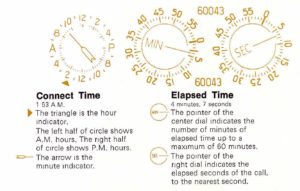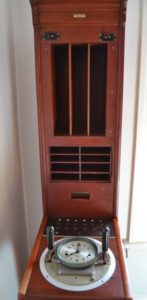TIME IS MONEY
On May 20, Behind the Steam will examine the pair of Kellogg Switchboard & Supply Company wooden box wall telephones that were once in the Marshall Brothers Mill office (now the State Parks office) and Auburn Heights mansion. Both telephones were found to be functional, and as part of museum renovations, wiring and space was designated for their installation and use. Subsequently, both telephones were restored and now are functional in the museum (but ONLY between EACH OTHER since they won’t work on today’s modern digital telephone systems). A museum visitor can experience the poor sound volume and quality of an early telephone call, unlike today’s modern devices with reliability and quality similar to having a person thousands of miles away sound as if they were right next to you.
The first telephone exchange for the Hockessin area was established December 30, 1899, by the Delaware & Atlantic Telegraph & Telephone Company. Located in Dr. Ball’s Drug Store, the switchboard initially served six subscribers when made operational. Within a couple months the switchboard served a dozen Hockessin area subscribers, including the Marshall family and Marshall Brothers Company.
Quarterly payments, starting in April 1900, made by Marshall Brothers Company to Delaware & Atlantic Telegraph & Telephone Company vary each quarter as posted to the general ledger. This is no doubt the result of toll calls being made. While the Marshalls had a private line between the mansion and mill office, a call to “central” in Hockessin allowed the family to communicate with any other subscribers connected to the Hockessin switchboard. When Israel needed to call one of the vulcanized fibre companies in Wilmington, it required making a toll call.
Any call from Hockessin to Wilmington or Newark, Delaware, or to Kaolin or Kennett Square, Pennsylvania, would have been a toll call during the first years of 1900. There was a device used by telephone operators to document the duration of the long-distance call that determined the cost of that call. What was the device called, and how did it function? Hint: the device was originally designed and patented for use in billiards halls!
Answer
For the earliest long-distance phone calls, an operator would simply look at a clock hanging above the operator’s station and note the time on a toll-call card along with an identification for the person placing the long-distance call. When the call was over, parties were to “ring off” with the operator to let the operator know the call was over. The operator then noted the end time on the toll-call card and handed to the supervising operator for calculation of the time spent on the call and logging against the customer’s account for the current billing period. This process suffered from math errors in time calculation, rate calculations, and even logging a long-distance call against a different account than it should have been. If the callers forgot to ring off with the operator at the end of their long-distance call, time accrued until the operator checked the line to find no one talking and would then log out the call.
Henry Abbott was a watch-smith in New York City. Abbott realized that “elapsed time” had value and that many businesses bought and sold “elapsed time” as a commodity. Abbott had nearly three dozen patents, his first in 1876 detailing a means for a watch stem to both wind a watch as well as move the hands to set the time! Billiard halls of the late 1800s covered their operating expenses by charging to use their tables. It was playing billiards that Abbott realized “time is money.”
 Recognizing the issues with hand-tallied time tickets, Henry invented an “Apparatus for Recording Measurements of Time, Space, or Quantity” in 1891 (patent 449192). In 1894 the first Calculagraph was installed by Pacific Telephone & Telegraph Company to time long-distances calls between Los Angeles and San Francisco. Six years later he received a patent for the Calculagraph (patent 583320), which quickly found use in telephone exchanges across the country as this device actually printed the time on a standard payroll ticket inserted into the device.
Recognizing the issues with hand-tallied time tickets, Henry invented an “Apparatus for Recording Measurements of Time, Space, or Quantity” in 1891 (patent 449192). In 1894 the first Calculagraph was installed by Pacific Telephone & Telegraph Company to time long-distances calls between Los Angeles and San Francisco. Six years later he received a patent for the Calculagraph (patent 583320), which quickly found use in telephone exchanges across the country as this device actually printed the time on a standard payroll ticket inserted into the device.
Henry, in 1904, improved on his earlier patent by designing a Calculagraph specifically for telephone use where the device was electrically connected to long-distance telephone lines between city pairs of telephone exchanges. While early Calculagraphs relied on a Seth Thomas #10 eight-day, double-spring balance, mechanical clock movement, later Calculagraphs had synchronous electric motor clock movements. The Calculagraph Company of East Hanover, NJ (today named Control Products, Incorporated) estimates there were more than 100,000 Calculagraphs in operation before rotary dialed long-distance technology replaced the need for long-distance operators and the Calculagraph.
Ben Franklin wrote in his Advice to Young Persons Intended for Trade — “Remember that time is money. He that can earn ten shillings a day at his labour, and goes abroad, or sits idle one half of that day, though he spends but sixpence during his diversion or idleness, ought not to reckon that the only expence; he has really spent, or rather thrown away, five shillings besides,” perhaps the first time the phrase “time is money” may have been used. It is the Calculagraph’s long-distance telephone call use that historians cite for introducing the phrase “time is money” into our mainstream vernacular as the device measured time in terms of money.
 Inside Calculagraph in addition to the clock mechanism, are three circular printing wheels powered by the clock mechanism. The left wheel is a clock face with a perimeter rotating arrow indicating the hour and a central rotating hour indicating the minute the call began. The center wheel indicates minutes and the right wheel indicates seconds both with rotating arrows in the center. At the start of the call the operator inserts a toll ticket with the ID of the long-distance line being used and pushes the right handle on the Calculagraph forward to print the starting time (left dial) followed by pulling the right handle back to print just the hollow dial faces for minutes and seconds (no central arrows). The toll ticket is then removed and placed in a holder. At the completion of the call, the toll ticket is returned to the Calculagraph where the left handle is pulled. The arrows for the minutes and seconds dials now print to show the elapsed time in minutes and seconds for the call.
Inside Calculagraph in addition to the clock mechanism, are three circular printing wheels powered by the clock mechanism. The left wheel is a clock face with a perimeter rotating arrow indicating the hour and a central rotating hour indicating the minute the call began. The center wheel indicates minutes and the right wheel indicates seconds both with rotating arrows in the center. At the start of the call the operator inserts a toll ticket with the ID of the long-distance line being used and pushes the right handle on the Calculagraph forward to print the starting time (left dial) followed by pulling the right handle back to print just the hollow dial faces for minutes and seconds (no central arrows). The toll ticket is then removed and placed in a holder. At the completion of the call, the toll ticket is returned to the Calculagraph where the left handle is pulled. The arrows for the minutes and seconds dials now print to show the elapsed time in minutes and seconds for the call.


